Tailwind Tribes: A Step-by-Step Guide to Exploding Your Pinterest Traffic Fast
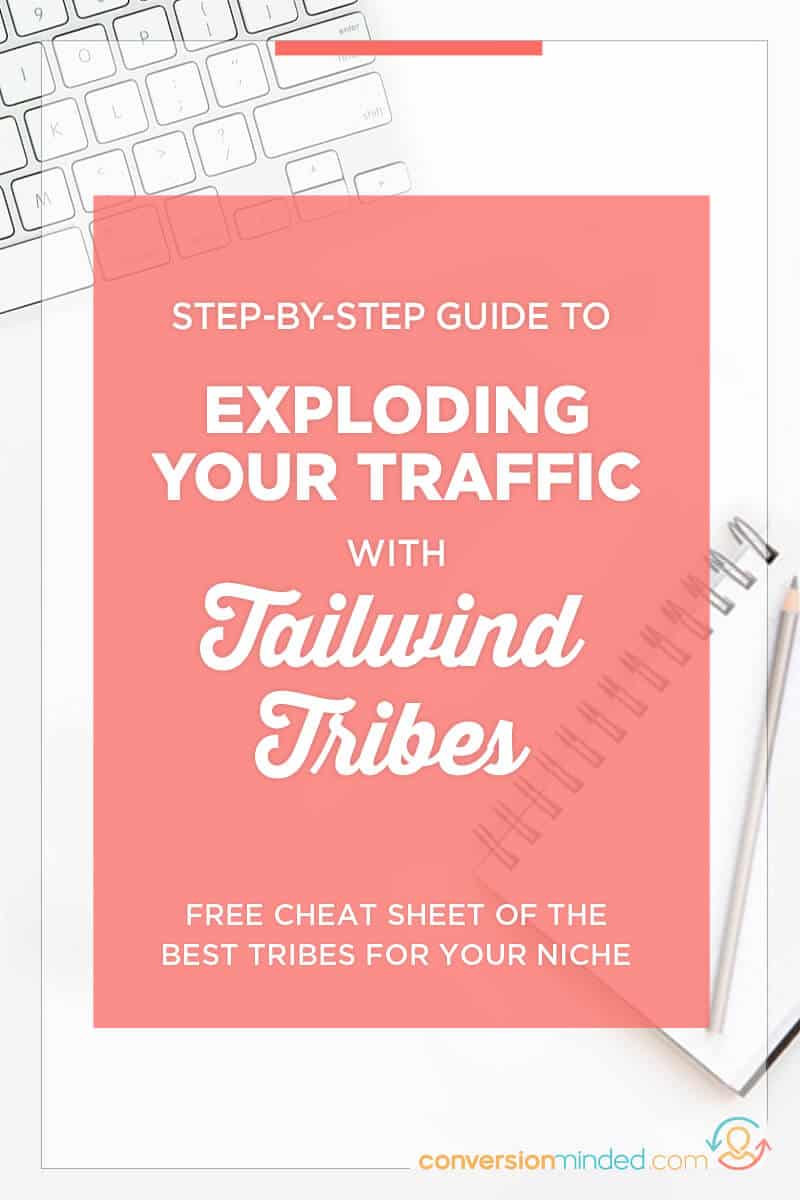
Do you use Tailwind tribes for your blog or business?
I started using it when it was still in beta, back when my traffic was tanking, and I was desperate to get it back.
I wanted my pageviews back up, and quick, so I pounced on tribes hard.
At first, I’d stare at the dashboard wondering What the heck do I do? Which tribes should I join? How do I even submit pins, and which ones should I share?
Sound familiar?
If you’re itching to explode your reach through Tailwind tribes but feel a bit stumped with where to start, this post will help. I’m sharing everything I’ve learned to help you get maximum results.
And if you’re curious, tribes did help me recoup some of my lost pageviews. While it didn’t solve my bigger issue (not posting consistently), it sure gave me the bump I needed.
Now, about that bigger issue:
A huge lesson I’ve learned is that there are NO SHORTCUTS!! We absofreakin’lutely must create content on the regular if we want to see steady, organic growth.
[clickToTweet tweet=”You need to create and share content on the regular if you want to see steady, organic growth in your blog or business.” quote=”You need to create and share content on the regular if you want to see steady, organic growth in your blog or business.”]
But I digress, back to tribes. I can’t think of a better time to jump on the bandwagon. If you haven’t already, you’re just in time to join the party. Tribes have seen massive growth in the last few months, and new ones are popping up every day.
More tribes = more reach = more people exposed to your content.
Alrightie, let’s dig in.
Bonus: I created a tribes cheat sheet with a list of the most active tribes for many niches. It includes the activity and visibility of the best performing tribes, plus invitation links, member counts, and rules so you can easily join the ones you want. A complete life-saver! Just click the image below to download.
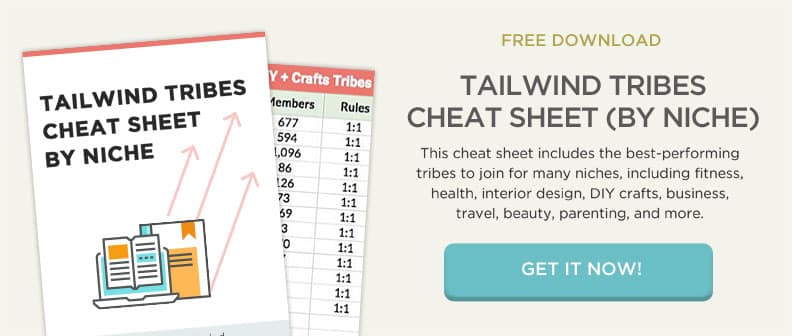
This post contains affiliate links, which means I may receive a small commission, at no cost to you, if you make a purchase through a link.
1) First, what is a tribe?
Tribes are a group of professionals who come together to share each other’s pins and give each other a boost in traffic, similar to share-for-share Facebook Groups – with a twist. Tribes are created around specific niches, industries, or interests, which means you’ll have a pool of content to share this is specific to your audience.
When you add your pins to a tribe, other tribe members can view, schedule, and repin it to their boards. This means you have access to the collective audience of your peers and can drive massive traffic to your posts, just by participating.
And you can hand-pick content you want to share with the tribe (and in turn, with your audience). Other tribe members can do the same. You end up with a continuous stream of hand-picked content as everyone contributes.
For example:
Let’s say you join a food tribe.
On Monday morning, you submit your avocado chocolate pudding pin and repin Mary’s eggplant lasagna to your Paleo board. Later that day, Harry, another tribe member, shares your avocado pin to his Delicious Desserts group board. On Tuesday, someone in Harry’s group repins it, which leads to 500 repins and 50 pageviews, just like that.
Can you see the snowball effect happening here? It’s that easy to get more traffic, reach, and repins through tribes.
Now, let’s drill down even more.
If you want, you can watch this video to see tribes in action:
How Do Tailwind Tribes Work?
2) How can tribes help improve your Pinterest rankings?
Now, I bet you’re thinking Curating content is nothing new. Been there done that!
You’re so right! Networking and sharing content is not a new strategy. There are sites like Feedly, Quuu, JustRetweet, Zest (my new favorite), plus engagement pods, share-for-share groups, and more.
Here’s the thing about Pinterest:
Both pin AND domain quality are huge ranking factors. When Pinterest sees you as sharing quality content that adds value, your pins will likely rank higher in search results.
Bottom line, the SmartFeed is watching everything we share, yo. ????
The more pins we can share (both original and curated) with a high number of repins, comments, and clicks, the better chance we have of getting traffic from Pinterest.
That’s where Tailwind tribes come in.
Remember back in the day, how easy it was to keep the SmartFeed happy? When we could tell which pins were popular by the number of repins? With Tribes, we get repin counts back, baby!
3) How much do Tailwind Tribes cost?
Tribes are add-ons (called PowerUps), and you don’t have to pay Tailwind to use them. You can access them directly from your dashboard, even with a free account. The best part is, you can also join tribes for free. #DOUBLEFREE
With Tribes Free, you can join five tribes and share 30 pins a month. And if you’re curious, that’s an aggregate number of pins across all tribes. I didn’t know that at first! Once you’re comfortable, you can power up to Tribes Pro and get access to ten tribes (80 total submissions) for just under $60 a year.
Pricing scales up from there. Here’s a breakdown:

Ready to join Tailwind and start using tribes? Use the link below to get started:
I was so excited about tribes at first that I joined every single one I could find relevant to my niche.
Fast forward months later and it turns out that tribes are much like groups: Not all are created equal, friend.
Whatever you do, take advantage of the Tribes Free and start with five tribes. Track the performance for a month and use that data to weed out the good from the bad. Then power up from there.
4) How are tribes different from Pinterest groups?
Great question! As I mentioned, tribes are similar to groups in that some will perform better than others.
The point of participating in both groups and tribes is to:
- Curate and share high-quality content
- Drive traffic to your website and business
- Stay on the good side of the Pinterest SmartFeed
The difference is that many groups are lame in terms of moderation. Group boards can easily turn into a moshpit of pins, with collaborators who neglect the board and rarely repin content. Because of this, groups have lost a bit of their mojo. There’s only a handful in any niche that will perform well.
Tailwind tribes come with a measure of accountability, so you can get some of that mojo back. What I mean by this is that every tribe member has to “share for share” according to the group rules or risk getting banned.
Why do I say “measure of accountability”?
Because it’s not absolute.
Tribe members don’t have to share your content at all. The only thing they HAVE to do is share pin for pin. They can choose other pins and ignore your content entirely (which can and does happen!).
That’s why it’s crucial to track the performance of every tribe you join to make sure it’s working for you. More on that in step #6 below.
How do you join the right tribes?
This is a bigger question than you might think!
First of all, it should be a no-brainer to join tribes in your niche. You want the right audiences to see your content.
Next, since we know that some tribes will be rock stars and others will be total duds, joining the right tribes has less to do with finding them and more to do with evaluating them.
Let’s start by finding them.
Psst…You can save a ton of time by downloading this handy cheat sheet of the best-performing tribes in your niche:

5) How do you find the right tribes to join?
You can either join through an invitation or from the Tribes tab within Tailwind.
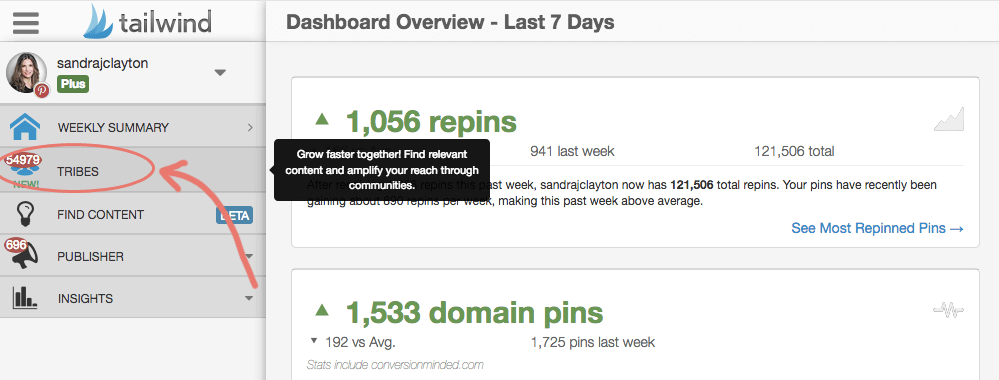
From there, enter a keyword related to your niche.
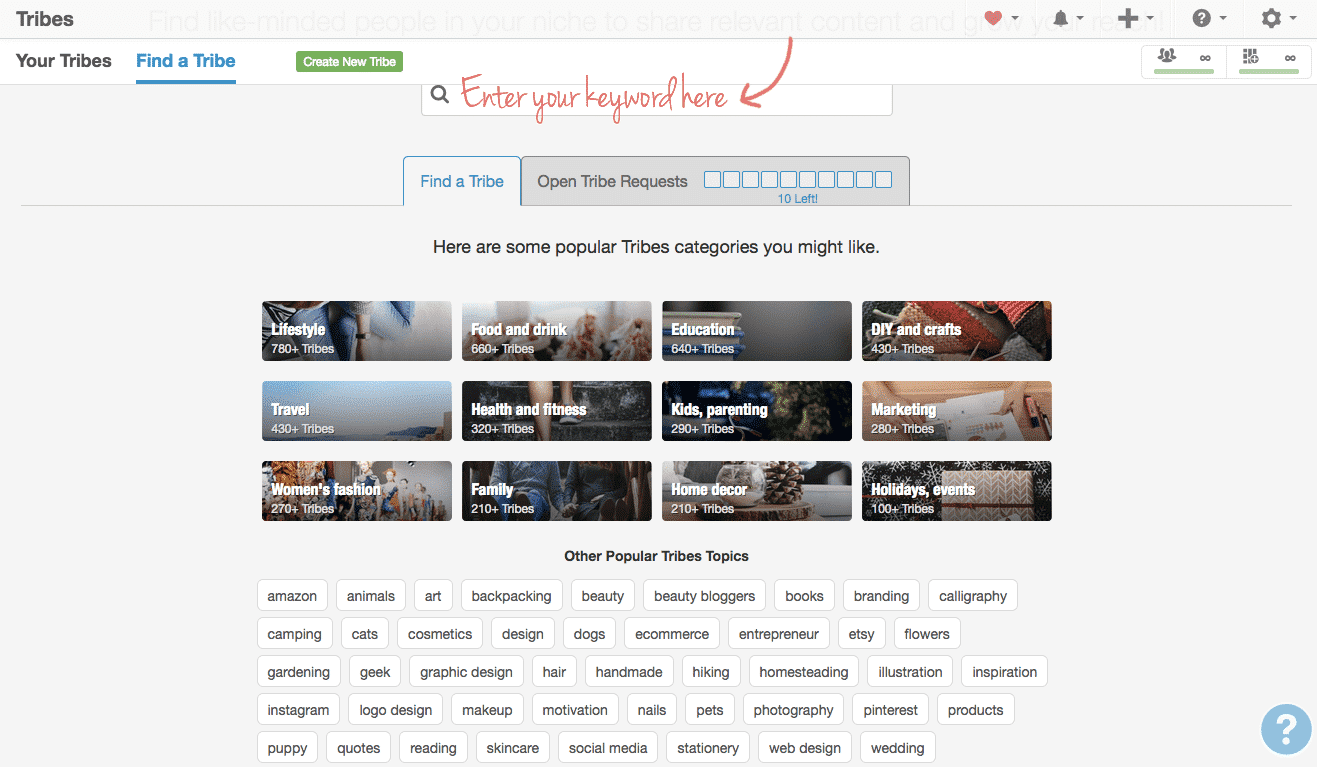
6) How do you evaluate tribes?
This is the thing that took me a while to get, and it’s a biggie.
You want to evaluate the quality of tribes in much the same waythat the SmartFeed evaluates your domain. I recommend evaluating tribes before you join, and then monthly once you’re an active member (step #9 below).
- Activity – how active are the tribe members?
- Quality + relevance – are the pins high quality?
- Rules – how many pins can you submit, what’s the share-for-share ratio?
- Number of members – how many people have joined?
- Visibility – what’s the process to join?
Activity
Once you enter a keyword, you’ll see a list of tribes along with the member count and overall activity.
(Activity is tribe-speak for engagement.)
The more bars the better.
From my experience, 3 bars or fewer means the tribe is a dud. You’ll wind up dumping a zillion tribe pins on your boards with little return. More bars, on the other hand, means the tribe has rock-star potential.

Quality and relevance
On the left side of the search results is a Preview Tribe button (pictured above). Select that to preview the tribe’s members, pins, topics, and visibility.
Before you join, make sure the content is relevant to your audience and appears to be high quality. Some of the tribes I’ve joined have delivered poor results because they covered many different topics. While large tribes can be appealing, your pins can easily get lost in the shuffle if the topics covered are not specific to your audience.
This is where bigger tribes may not mean bigger results. I’ve found the more you niche down with tribes, the more likely your pins will be reshared and repinned.

Tribe rules
Rules cover things like:
- Maximum pins – the number of pins you can submit daily
- Reposting – how frequently you can post the same content
- Pin quality – image orientation and other deets
- Blog topics – topics covered in the tribe
- Types of posts – most are blog post only, meaning no pins to affiliates, products, or pages
- Share ratio – number of tribe pins you have to share for every pin you submit
That last one is the one you want to pay close attention to.
I aim for tribes with a 1:1 share ratio. The reason is that I have enough of my own content to share and prefer to feature my pins more than others.
Now, if you’re just starting a blog and don’t have many original pins yet, a 1:2 or even 1:3 ratio may suit your needs perfectly.
Here’s what those ratios mean:
- 1:2 = You share two tribe pins for every pin you submit
- 1:3 = Share three tribe pins for every pin you submit
- And so on…
Higher ratios mean you’ll have plenty of content to add to your Pinterest boards while you build up a content library of your own. Once you do, you’ll want to drop the ratio back down to 1:1. The reason is that if you create and share high-quality pins (which I’m sure you do!), you’ll likely find that your pins will get the most engagement.
Remember, the SmartFeed’s watchin’. ????
Number of members
These days, I’m all about fewer members. Smaller tribes rock for a number of reasons:
- Your pins are more likely to be shared because they’ll stand out more.
- You’ll have less competition.
- The tribe content will likely be relevant to your audience, which means you won’t have to scroll through ten recipe pins to find one self-help pin.
To be fair, I haven’t formally tracked member size to performance. I just prefer smaller tribes and highly recommend them.
Visibility (aka Access)
This is a fancy word for “how to join the tribe.”
If you’re curious, you can view a tribe’s visibility by selecting that Preview Tribe button I showed you above. Visibility is right there under the description:
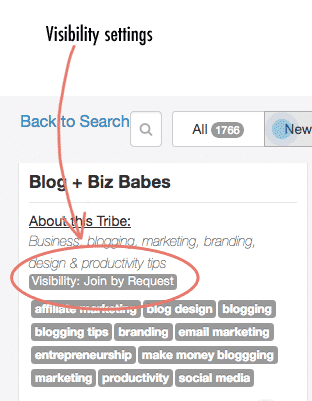
There are three levels of visibility:
- Public – This one’s the easiest. You can join without approval.
- By Request – Send the owner a request to join (which you can bypass with an invitation)
- Secret – The only way to join is by invitation. Secret tribes are not searchable in Tribes.
There you go! With the five metrics listed above, you can evaluate tribes before you join to see which ones may be a good fit.
On to #7!
Don’t forget to download the Tailwind tribes cheat sheet below.

7) How many tribes should you join?
I’d say between five and ten to start. Again, make sure you track the performance after your first month, and monthly after that.
I joined a ton at first and had loads of fun sharing and submitting, but I sobered up quickly when I saw my boards carpet-bombed with literally hundreds of tribe pins. Say whaa?
A much better approach is to start small, track them all, and scale up from there.
8) How do you share to tribes?
The same way you schedule pins. Find a pin in your Pinterest feed and select the Tailwind logo. Then, instead of entering a board name, scroll down until you see the Add to Tribes button.

Once you select it, you’ll get a pop-up window with a list of tribes. Select the tribes to which you want to submit the pin. Tip: Use those checkboxes on the left to select multiple tribes.
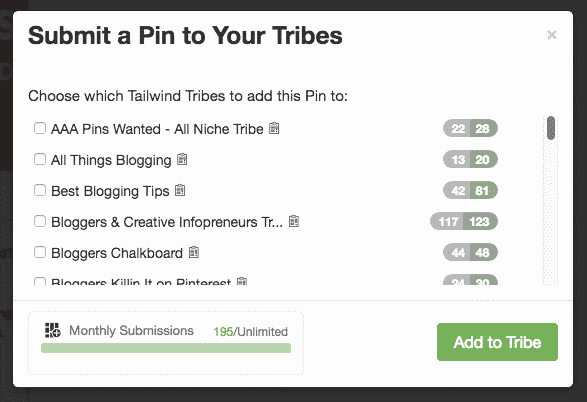
If you’ve already submitted the same pin to a tribe, Tailwind will flag it and let you know. Easy peasy.
#PROTIP: If you’re like me, you’re a member of many tribes and active in only a handful (those high-performing ones!). You can zip through this step by keeping a spreadsheet of active tribes so you can easily see which ones to select.
Don’t forget! You still have to go back to Tailwind and manually share from each tribe according to the rules.
Ready to join Tailwind and start using tribes? Use the link below to get started:
9) How do you keep track of the pins you share?
Easy! That spreadsheet I mentioned in step #8 doubles as a tribe tracker. Use it to organize your pin and post URLs and keep track of the dates you share each pin.
If you’re curious, here’s what my tracker looks like:
![]()
The tracker even triples as a reposting scheduler. Boom. You’ll know exactly when to recycle your pins, following the rules of your tribes.
Speaking of tracking, time to drill down on stats…
How do you track a tribe’s performance?
We’ve talked about how to evaluate a tribe before you join it based on the overall activity, rules, members, and so on.
Once you’re an active member, you’ll want to drill down on the tribe’s performance as it relates to your pins.
The way to do that is to create your OWN share ratio. And I’m going to show you how to do that right now!
10) How do you create your own share ratio?
Beneath the rules for each tribe, you’ll see stats for reshares, repins and reach:
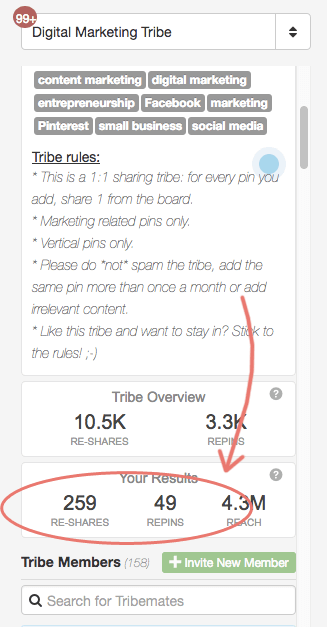
Just so you know, those are aggregate numbers across all of your submitted pins.
To calculate a tribe’s performance, divide the number of repins by the number of reshares.
For example:
In the Digital Marketing tribe above, my pins have received 49 repins and 259 reshares. That means the tribe members have shared my pins with their audience 259 times, and I’ve received 49 repins from those reshares.
49 / 259 = .189 or 18.9%
This means that my average number of repins to reshares for this tribe is roughly 19%.
Anything over 10% is a high-performing tribe, in my book, so that’s the yardstick I use to size up other tribes. I either leave or stop contributing to tribes that perform lower.
What should your ratio be? You’ll have to decide based on your tolerance level AND the average performance of your collective tribes. If most of your tribes perform at 5%, you may want to use that as a benchmark for other tribes. Or, maybe you search for tribes with better potential.
That’s a wrap! How about you? Have you used Tailwind Tribes to skyrocket your Pinterest traffic? I’d love to hear your feedback!
Don’t forget to grab the tribes cheat sheet with the most active tribes for each niche. It’s so easy to measure the performance of tribes when you have all your stats in one place.








These are great tips! I am new(ish) to Tailwind and Tailwind tribes and I am still trying to figure it all out. Thanks for sharing and all these downloads are great!!
A very detailed.. informative and useful article..will certainly help bloggers like me..
God bless you
This is a great guide. The one thing I’m not seeing here is how to track clicks from pins shared through Tribes. I’m seeing a lot of repins from the Tribes I submit to, but it doesn’t seem to equate to site traffic. I don’t know how to track that information, though, so I could be missing it.
Great question, Crystal! You can see traffic from tribes under Acquisition > Campaigns.
Super informative article about Tribes! Love the video especially! You explained the whole concept very well! Thank you!
This is a great post! You’re probably not reading comments on this anymore but just in case you are, I have a question. You were talking about how much it costs to join to get more than 5 tribes but then you said you joined as many as you could. Did you immediately go to a pro plan?
Hi Maggie! I signed up for the pro plan pretty quickly…definitely worth it.